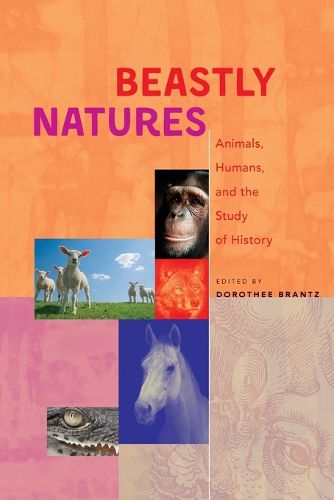Readings Newsletter
Become a Readings Member to make your shopping experience even easier.
Sign in or sign up for free!
You’re not far away from qualifying for FREE standard shipping within Australia
You’ve qualified for FREE standard shipping within Australia
The cart is loading…






This title is printed to order. This book may have been self-published. If so, we cannot guarantee the quality of the content. In the main most books will have gone through the editing process however some may not. We therefore suggest that you be aware of this before ordering this book. If in doubt check either the author or publisher’s details as we are unable to accept any returns unless they are faulty. Please contact us if you have any questions.
Although the animal may be, as Nietzsche argued, ahistorical, living completely in the present, it nonetheless plays a crucial role in human history. The fascination with animals that leads not only to a desire to observe and even live alongside them, but to capture or kill them, is found in all civilizations. The essays collected in Beastly Natures show how animals have been brought into human culture, literally helping to build our societies (as domesticated animals have done) or contributing, often in problematic ways, to our concept of the wild. The book begins with a group of essays that approach the historical relevance of human-animal relations seen from the perspectives of various disciplines and suggest ways in which animals might be brought into formal studies of history. Differences in species and location can greatly affect the shape of human-animal interaction, and so the essays that follow address a wide spectrum of topics, including the demanding fate of the working horse, the complex image of the American alligator (at turns a dangerous predator and a tourist attraction), the zoo gardens of Victorian England, the iconography of the rhinoceros and the preference it reveals in society for myth over science, relations between humans and wolves in Europe, and what we can learn from society’s enthusiasm for political animals, such as the pets of the American presidents and the Soviet Union’s space dogs. Taken together, these essays suggest new ways of looking not only at animals but at human history.
Contributors
Mark V. Barrow Jr., Virginia Tech * Peter Edwards, Roehampton University * Kelly Enright, Rutgers University * Oliver Hochadel, Universitat Autonoma de Barcelona * Uwe Lubken, Rachel Carson Center, Munich * Garry Marvin, Roehampton University * Clay McShane, Northeastern University * Amy Nelson, Virginia Tech * Susan Pearson, Northwestern University * Helena Pycior, University of Wisconsin-Milwaukee * Harriet Ritvo, Massachusetts Institute of Technology * Nigel Rothfels, University of Wisconsin-Milwaukee * Joel A. Tarr, Carnegie Mellon University * Mary Weismantel, Northwestern University
$9.00 standard shipping within Australia
FREE standard shipping within Australia for orders over $100.00
Express & International shipping calculated at checkout
This title is printed to order. This book may have been self-published. If so, we cannot guarantee the quality of the content. In the main most books will have gone through the editing process however some may not. We therefore suggest that you be aware of this before ordering this book. If in doubt check either the author or publisher’s details as we are unable to accept any returns unless they are faulty. Please contact us if you have any questions.
Although the animal may be, as Nietzsche argued, ahistorical, living completely in the present, it nonetheless plays a crucial role in human history. The fascination with animals that leads not only to a desire to observe and even live alongside them, but to capture or kill them, is found in all civilizations. The essays collected in Beastly Natures show how animals have been brought into human culture, literally helping to build our societies (as domesticated animals have done) or contributing, often in problematic ways, to our concept of the wild. The book begins with a group of essays that approach the historical relevance of human-animal relations seen from the perspectives of various disciplines and suggest ways in which animals might be brought into formal studies of history. Differences in species and location can greatly affect the shape of human-animal interaction, and so the essays that follow address a wide spectrum of topics, including the demanding fate of the working horse, the complex image of the American alligator (at turns a dangerous predator and a tourist attraction), the zoo gardens of Victorian England, the iconography of the rhinoceros and the preference it reveals in society for myth over science, relations between humans and wolves in Europe, and what we can learn from society’s enthusiasm for political animals, such as the pets of the American presidents and the Soviet Union’s space dogs. Taken together, these essays suggest new ways of looking not only at animals but at human history.
Contributors
Mark V. Barrow Jr., Virginia Tech * Peter Edwards, Roehampton University * Kelly Enright, Rutgers University * Oliver Hochadel, Universitat Autonoma de Barcelona * Uwe Lubken, Rachel Carson Center, Munich * Garry Marvin, Roehampton University * Clay McShane, Northeastern University * Amy Nelson, Virginia Tech * Susan Pearson, Northwestern University * Helena Pycior, University of Wisconsin-Milwaukee * Harriet Ritvo, Massachusetts Institute of Technology * Nigel Rothfels, University of Wisconsin-Milwaukee * Joel A. Tarr, Carnegie Mellon University * Mary Weismantel, Northwestern University